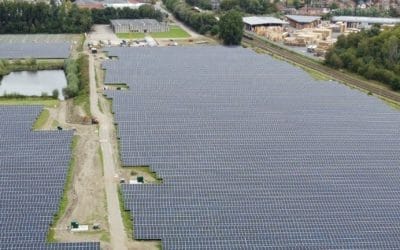‘Keeping the lights on’ in the UK is a significant challenge and with energy use on the rise, finding innovative solutions to help balance supply and demand remains a top concern.
National Grid has estimated that energy use could increase by around 30% by 2050, with factors including climate change, the electrification of the transport system and heat demands all playing their part. Added to this are ongoing issues with generation and supply, caused by an aging infrastructure and the planned decommissioning of all coal-fuelled power stations.
Low carbon developments such as Hinkley Point nuclear power station are being lined up to take some of the strain – although this development is itself not without controversy. The growth in the deployment of renewable technologies is also playing its part, with solar and wind accounting for up to a third of the UK’s electricity needs in the spring of 2017.
Against this backdrop, new strategies continue to emerge that aim to encourage and incentivise energy users – particularly high intensity commercial users – to adapt when and how they take power from the grid. With industry and the service sector consuming around 31% of the total energy used in the UK, such measures are proving vital.
What is demand response?
Demand response is an umbrella term used to refer to schemes that help balance supply and demand. The basic idea being that if there is a peak in demand, the grid needs to respond. The main purpose of demand response is to prevent demand outstripping supply. This is done by incentivising energy users to reduce or eliminate non-essential usage at peak times.
It is not a particularly new concept, but with increasing demands being made of the grid, the spread of renewable technologies and wider moves being made towards a low-carbon power network, it is currently something of a buzz word.
On the consumer side, a simple example of a demand response initiative in action is the Economy 7 tariff. Homeowners are offered a far lower tariff for using power at night, when demand is low. This helps take some of the pressure off the grid by shifting some non-essential processes. For commercial energy users, the basic idea is the same but the way it is actioned is often far more complex. There are many different schemes and incentives around, each having its own requirements and associated benefits.
How does it work?
Power companies can usually anticipate an event that may lead to a peak in demand – such as a cold snap in the weather, or faults in power generators or supply lines. These periods may last anything from 30 minutes up to four hours, depending on the cause.
With demand response, energy customers are asked in advance to watch their usage during the projected period and will be financially incentivised to do so. This may be an automated process whereby utilities can take control of equipment remotely, which allows them to react in seconds if they need to. Any processes affected must not impact on the crucial operations of a business, who must also have a way to opt-out and turn processes back on if they need to.
Companies may choose to work directly with National Grid, or through a third-party aggregator.
Key demand response approaches include:
- Rates incentives: such as time-of-use pricing, critical peak pricing, variable peak pricing, real time pricing and critical peak rebates
- Direct load control: which gives power companies the ability to turn commercial equipment on and off during peak periods, in exchange for financial incentives and lower energy bills
Opportunities for commercial energy users
Taking part in demand response is voluntary but has the potential to benefit businesses in several ways:
- Reduced energy costs
Energy charges may significantly increase during times of peak demand, potentially reaching up to 7 times higher. The less energy used by a company at these times, the lower their costs will be.
- Create additional revenue streams
On top of the cost savings, working with National Grid through one of the incentive schemes, or using energy storage technology to sell energy back to the grid at a higher rate, can help create additional income streams for a business.
Demand response mechanisms
The most common demand response mechanisms around today include:
- Short Term Operating Reserve (STOR) – this initiative jumps into action to reduce demand or increase generation with around ten minutes’ notice. Businesses can be paid for being available and ready to respond to a STOR event, and again for the energy they deliver.
- Frequency Control Demand Management (FCDM) – businesses can be paid a fee for making their load available for interruption. They are paid a fee for being available during a contracted period, even if it no interruption ends up being made.
- Triad management – one of the most lucrative but difficult demand response revenue sources to manage. The triad system is the way National Grid charges businesses for the cost of the transmission network. By reducing load and increasing generation when demand is at its highest, businesses can save or earn money.
- The Capacity Market – run as an auction, those businesses who are successful will benefit from a steady revenue stream (capacity payments) that encourage them to invest in new generation, or to keep existing generation available on the system. The capacity obligation means they must then be available to deliver energy when needed.
For full and detailed information about each mechanism, visit National Grid’s ‘Power Response’ site.
Taking action ‘behind the meter’
While it’s useful to understand the opportunities presented by demand response, and to capitalise on them if you can, it is no substitute for businesses reducing their energy use and improving their energy efficiency. By working ‘behind the meter’ – i.e doing everything possible to reduce the amount of energy being taken from the grid – energy expenditure can be substantially lowered.
This can be done in several ways, including by making energy efficiency upgrades that help reduce usage; by installing renewable technologies to generate power onsite (such as commercial solar pv panels); and by using energy storage units to maximise the yield of such technologies, while allowing it to be stored and released when needed. Taking action in this way will have the single greatest impact on energy costs and carbon emissions in the long run.
- You may also be interested in:
For more advice on any of the topics covered here, please call the commercial & industrial team at Anesco on 0845 894 44 44.






